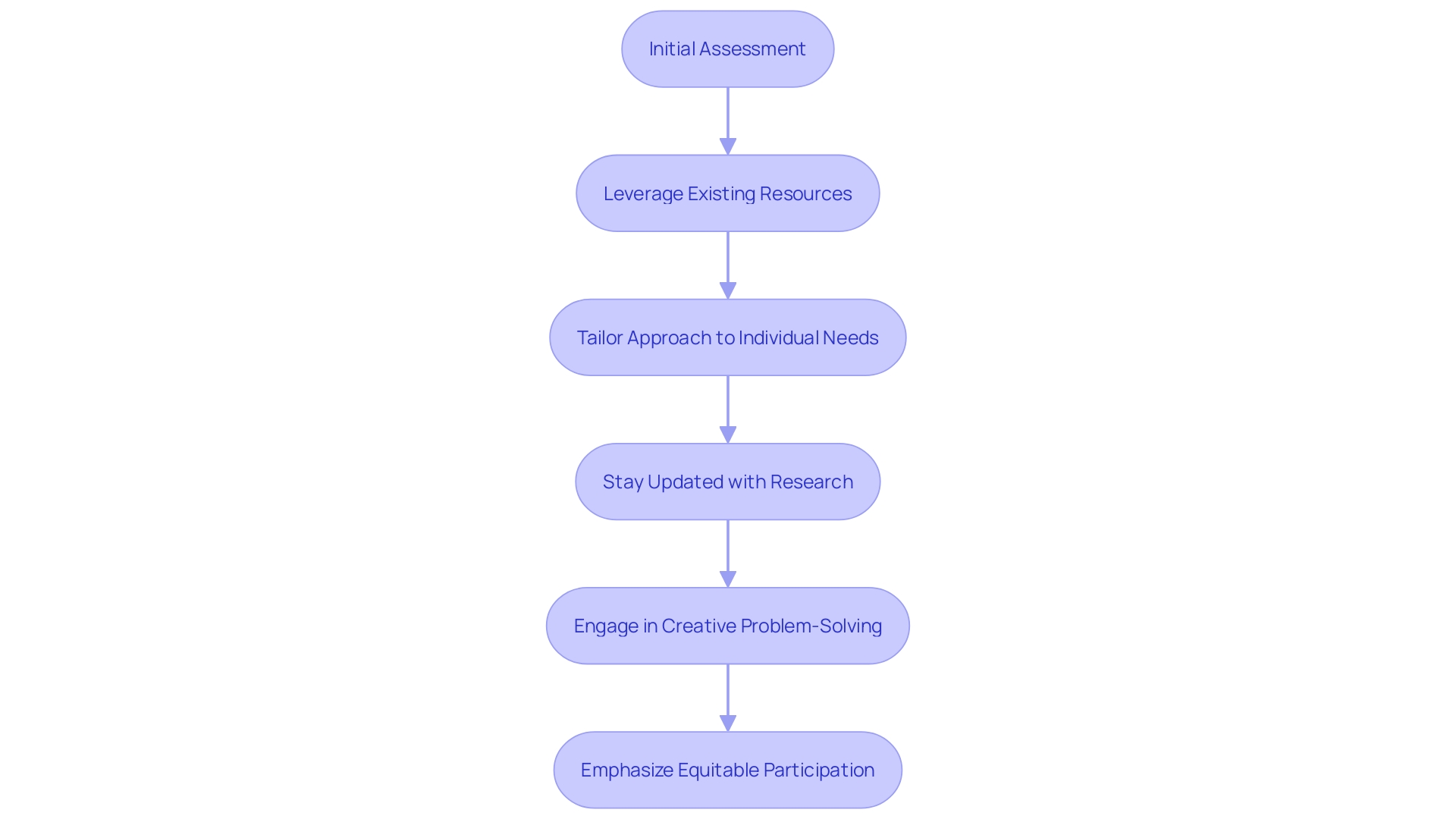Introduction
Discrete Trial Training (DTT) is a powerful technique used in Applied Behavior Analysis therapy to teach essential skills and behaviors to individuals with autism and ADHD. By breaking down complex tasks into simpler steps, DTT provides a structured approach that can be tailored to meet the unique needs of each learner. Beyond just teaching, DTT promotes equity and inclusion, ensuring that every child has the opportunity to participate meaningfully in their communities and reach their full potential.
With its step-by-step process and focus on measurement, DTT allows for effective progress tracking and improved behavior and emotional regulation. As we celebrate Autism Awareness Month, it is crucial to recognize the importance of accessible and effective therapies like DTT in addressing the complex needs associated with autism spectrum disorder. By embracing technology solutions and coordinated care, we can ensure that high-quality and equitable therapy is delivered to enhance the well-being of autistic children and their families.
Understanding DTT (Discrete Trial Training)
Discrete Trial Training (DTT) stands out as a core technique in Applied Behavior Analysis (ABA) therapy, designed to teach individuals with autism and ADHD vital skills and behaviors. By breaking down complex tasks into simpler steps, DTT provides a structured approach that can be individualized to meet each learner's needs. This method is not just about teaching; it's about fostering equity and inclusion in the educational and social arenas. With DTT, every child has the opportunity to participate meaningfully in their communities and develop to their full potential. Embracing the ethos that every child deserves a fair race, DTT ensures that those with disabilities are not left behind and are provided with the consistent support essential for their mental health and well-being. The technique involves a step-by-step process that includes prompting, reinforcement, and a clear beginning and end to each trial, which allows for focused learning and the ability to measure progress effectively. With the prevalence of autism spectrum disorder (ASD) and the high rate of co-occurring intellectual disabilities, it is crucial to equip children with the tools they need for daily social interactions. DTT, as an evidence-based intervention, has been shown to improve behavior and emotional regulation, thereby enhancing the quality of life for autistic children and their families. As we consider the challenges of implementing such therapeutic approaches in diverse settings, it is evident that technology solutions and coordinated care are pivotal to delivering high-quality, equitable therapy. This month, dedicated to raising autism awareness, sheds light on the importance of accessible and effective therapies like DTT, which play a significant role in addressing the complex needs associated with ASD.
Benefits of DTT
Discrete Trial Training (DTT) is a structured method of teaching that enhances the learning process for those undergoing ABA therapy. By breaking down complex tasks into smaller, manageable steps, DTT fosters skill acquisition in a way that is both measurable and reproducible. With a clear beginning and end to each trial, learners can better focus and attend to tasks, which in turn contributes to a more conducive learning environment. This technique is especially beneficial for individuals with learning disabilities, who represent approximately one in ten children and require tailored educational approaches due to their unique cognitive processing methods.
Furthermore, DTT empowers learners by promoting independence through the mastery of specific skills, allowing them to navigate their environment with greater confidence. The effectiveness of DTT and other ABA-based interventions is not only supported by clinical knowledge but also by the technological advancements that assist in coordinating care. Experts in the field, such as Board-Certified Behavior Analysts with extensive clinical experience, underscore the importance of high-quality, coordinated care that is facilitated by technological enhancements.
These professionals are at the forefront of integrating technology solutions that streamline review processes, ensuring that best practices are consistently applied. This commitment to excellence in care coordination and technology innovation reflects a broader shift towards optimizing therapeutic outcomes for individuals with disabilities, allowing them to participate fully and equitably in all aspects of life.

Implementing DTT: Strategies and Best Practices
To effectively implement Discrete Trial Training (DTT), it's crucial to adopt a strategy that encompasses rigorous planning and intelligent execution. Best practices in DTT involve a comprehensive approach, from the initial assessment to the actual therapy sessions, enhancing the learning experience for individuals.
The process begins with a thorough initial assessment to determine the appropriateness and security of the techniques to be used, ensuring they meet the necessary standards. This step often reveals that many resources and solutions are already in place, which can be leveraged for DTT, as seen in digital technology assessments within healthcare systems.
Incorporating the input from clinicians through detailed questionnaires helps to tailor the DTT approach to the specific needs of the individual, justifying the choice of techniques and their anticipated role in addressing the challenges faced.
Moreover, keeping abreast of the latest research and advancements is essential. For instance, discussions on sustainable adoption of evidence-based practices provide insights into creating a foundation for lasting change in therapeutic settings.
In practice, the application of DTT is not just about adhering to a set procedure but also about engaging in a creative and resourceful manner. This aligns with the notion that focusing solely on problems can hinder progress, whereas drawing on inner resources and finding creative solutions can lead to significant breakthroughs.
Statistics highlight the importance of equitable and supportive participation in various life domains, emphasizing the role of well-implemented DTT in contributing to the mental health and overall well-being of individuals, particularly those with disabilities.
In summary, effective DTT implementation is a multi-faceted endeavor that requires careful consideration of existing resources, individualized planning, ongoing research engagement, and a creative, solution-focused approach to ensure successful learning outcomes.

Supportive Strategies for Home and School
Discrete Trial Training (DTT) is a structured instructional strategy utilized in ABA therapy that has shown effectiveness in enhancing the learning of children with autism and other developmental disorders. To maximize the impact of DTT, its principles can be seamlessly integrated into daily routines at home and school, allowing for the reinforcement of skills and the promotion of generalization across various settings.
Project Follow Through, initiated in 1968, stands as a testament to the power of community-selected educational approaches, involving over 200,000 children in 178 diverse communities. This extensive educational experiment demonstrated that when parents and educators collaborate on the chosen method of instruction, the implementation is more robust, leading to improved outcomes for children, especially those at risk. Similarly, embracing the philosophy of unschooling, which is deeply rooted in tailoring learning to a child's interests and daily experiences, can complement DTT by fostering an environment where education is a natural part of life.
Moreover, the digital age presents new opportunities for supporting children with ADHD and autism. EndeavorRx, for instance, is a digital therapeutic recommended for use in short, consistent sessions, aiming to improve attention function through sensory stimuli and motor challenges. This innovation, part of the rapidly growing digital therapeutics sector, showcases how technology can be harnessed to supplement traditional therapies and engage children in their learning journey.
In light of these insights, it is crucial for parents, educators, and therapists to work synergistically, ensuring that the strategies and interventions employed are not just confined to therapy sessions but are woven into the fabric of the children's everyday lives. By doing so, we can create a supportive and enriching environment that empowers children to thrive and reach their full potential.
Conclusion
In conclusion, Discrete Trial Training (DTT) is a powerful technique in Applied Behavior Analysis therapy that breaks down complex tasks into simpler steps. It promotes equity and inclusion, ensuring every child has the opportunity to reach their full potential. DTT's step-by-step process and focus on measurement allow for effective progress tracking and improved behavior and emotional regulation.
DTT plays a crucial role in addressing the complex needs associated with autism spectrum disorder. It improves behavior and emotional regulation, enhancing the quality of life for autistic children and their families.
Implementing DTT effectively requires rigorous planning, tailoring the approach to individual needs, and staying informed about the latest research. Well-implemented DTT significantly contributes to the mental health and overall well-being of individuals with disabilities.
To maximize the impact of DTT, its principles can be seamlessly integrated into daily routines at home and school. Collaborating with parents and educators leads to improved outcomes. Embracing unschooling and utilizing digital therapeutics enhance the learning experience.
In conclusion, DTT is a powerful and effective technique that promotes equity and inclusion in therapy. By embracing technology solutions and coordinated care, we can deliver high-quality and equitable therapy to enhance the well-being of autistic children and their families. Let us continue to advocate for accessible and effective therapies like DTT to support the well-being and success of our children.




